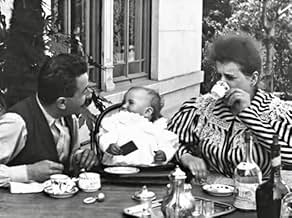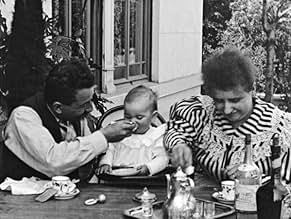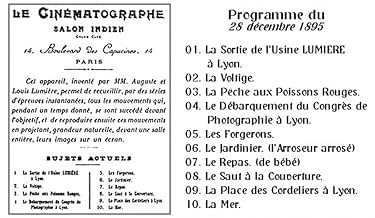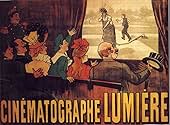Repas de bébé
- 1895
- 1min
NOTE IMDb
5,9/10
3,7 k
MA NOTE
Ajouter une intrigue dans votre langueAs part of a maiden public film screening at the Salon Indien, on December 28, in Paris, Auguste Lumière pivots the centre of attention around his baby daughter, as he tries to feed her from... Tout lireAs part of a maiden public film screening at the Salon Indien, on December 28, in Paris, Auguste Lumière pivots the centre of attention around his baby daughter, as he tries to feed her from a spoon.As part of a maiden public film screening at the Salon Indien, on December 28, in Paris, Auguste Lumière pivots the centre of attention around his baby daughter, as he tries to feed her from a spoon.
- Réalisation
- Casting principal
Avis à la une
One of the first films ever made, the film seems extremely primitive: there is no dialogue or plot or characters. However, in 1895, it was a new technological breakthrough. It is interesting to watch; the Lumière brothers were the first film makers and pretty much invented the technology, along with Edison.
Repas de Bebe was one of the films on the bill of the Lumiere brothers' first exhibition of motion pictures for a paying audience. The basement room of the Hotel Salon Indien the brothers hired for the occasion was half-empty on the first ever cinema screening - but the second night was a sell-out. Of course, by today's standards most of the film's appear quite crude and this one is no great shakes but it does capture a tender family moment as Auguste Lumiere and his wife feed their baby son. It's a shot that's been repeated millions of times since by anyone who ever had a family and owned a cine camera/video camera or mobile phone, and as such there's a certain poignancy to it.
A father with his wife at the table feeds his son , who then offers a cookie to his parents while the wind moves the trees. There is a time when children will have to feed their aged parents and already before time this child offers them food!
On a cold day of December in 1895, two photo technicians named Auguste and Louis Lumière rented the Salon Indien Du Grand Café to show the results of a series of experiments they had been making since 1892. As workers of their father's photographic firm, their work in the development of better process to make photographs wasn't unknown, but what the brothers showed to their limited audience that day was far beyond what anyone could have imagined. On that day, cinema was born, as the brothers' invention, the Cinématographe, allowed to project moving images on a screen, a considerable improvement over the popular Kinetoscope (which showed the images through a peephole). As photographers themselves, the brothers considered their invention to be the natural evolution of photography, so most of the movies they showed that day were done to show the idea that like photography, cinema was here to capture memories, albeit in a more vivid way.
Of the 10 short films the brothers screened on that historical day, most were of course devised to show the movement of the images (people walking, exercising, or simply the traffic passing on the street), but the others had specific purposes to show the brothers' ideas of what kind of uses give to the new invention. One was of course the shooting of the arrival of the Congress of Photographers in Lyon, aimed to show cinema as a new way to document history; there was also "L'Arroseur Arrosé", which showed cinema as a way to tell a simple and fun little story; and finally, there were the movies that, like photographs, captured family moments. "Repas De Bébé" (literally, "Baby's Meal") was one of that kind of movie, as the film showed Auguste Lumière and his wife Marguerite, while they are having breakfast with their baby daughter Andrée.
While one could even say that the movie doesn't have anything special besides the fact that it was among the first movies screened in history; "Repas De Bébé" is probably the movie that represents the Lumières' ideal of cinema the most, as like a photography, the movie captures a charming moment in the life of a family that can be revisited anytime, with the advantage of having it moving. This meant that we could not only remember how persons looked in the past, we were now able to see how they behaved, what they did or simply how they really lived. It was more than a documentary or an actuality film, this was essentially a memory being caught on film and saved for posterity. One can make the argument that film videos were born with this movie, and for that reason alone, "Repas De Bébé" has a special place in the history of film. 6/10
Of the 10 short films the brothers screened on that historical day, most were of course devised to show the movement of the images (people walking, exercising, or simply the traffic passing on the street), but the others had specific purposes to show the brothers' ideas of what kind of uses give to the new invention. One was of course the shooting of the arrival of the Congress of Photographers in Lyon, aimed to show cinema as a new way to document history; there was also "L'Arroseur Arrosé", which showed cinema as a way to tell a simple and fun little story; and finally, there were the movies that, like photographs, captured family moments. "Repas De Bébé" (literally, "Baby's Meal") was one of that kind of movie, as the film showed Auguste Lumière and his wife Marguerite, while they are having breakfast with their baby daughter Andrée.
While one could even say that the movie doesn't have anything special besides the fact that it was among the first movies screened in history; "Repas De Bébé" is probably the movie that represents the Lumières' ideal of cinema the most, as like a photography, the movie captures a charming moment in the life of a family that can be revisited anytime, with the advantage of having it moving. This meant that we could not only remember how persons looked in the past, we were now able to see how they behaved, what they did or simply how they really lived. It was more than a documentary or an actuality film, this was essentially a memory being caught on film and saved for posterity. One can make the argument that film videos were born with this movie, and for that reason alone, "Repas De Bébé" has a special place in the history of film. 6/10
Louis Lumiere's brother, Auguste, and his wife sit at a table, in their garden, feeding their child - who sits between them. Shrubbery in the background rustles indicating a slight breeze. Perhaps the public, in 1896, would see this and wish they could preserve family scenes such as this for their posterity. Now, 107 years later, we can - on film or video. We have come a long way, baby!
Le saviez-vous
- AnecdotesFilm historians often jokingly refer to this film as the first 'home movie,' as it depicts the filmmaker's home life in a documentary fashion, without any attempt at narrative contrivances.
- ConnexionsEdited into The Lumière Brothers' First Films (1996)
Meilleurs choix
Connectez-vous pour évaluer et suivre la liste de favoris afin de recevoir des recommandations personnalisées
Détails
- Date de sortie
- Pays d’origine
- Langue
- Aussi connu sous le nom de
- Le déjeuner de bébé
- Société de production
- Voir plus de crédits d'entreprise sur IMDbPro
- Durée
- 1min
- Couleur
- Mixage
- Rapport de forme
- 1.33 : 1
Contribuer à cette page
Suggérer une modification ou ajouter du contenu manquant



















